Lesson |
Target language and skills |
Activities |
1 - 2 |
- Vocabulary building:
- tourist attractions in HK
- things to do as tourists in HK
- Speaking skills:
- language for expressing, agreeing & disagreeing opinions
- I think …. What do you think?
- So do I!/I agree with you. I also think…
- Well, I'm not so sure. I think…
- reading aloud descriptions and names of tourist attractions
- Listening skills:
- recognising names of tourist attractions
- Writing skills:
- writing a shape poem about a tourist attraction
|
- Group competition:
- Students watched "Hong Kong – Live it. Love it!", a promotional video by HK Tourism Board to identify
- as many tourist attractions shown on it as they could
- as many things tourists can do in HK as they could
- Students learnt vocabulary of tourist attractions in Hong Kong.
- Students played a card game
 matching tourist attractions with descriptions about them. matching tourist attractions with descriptions about them.
- Students learnt phrases and useful expressions for agreeing and disagreeing with others during discussions.
- Students played a bingo game
 to recycle the words they had learnt about tourist attractions in Lesson 1. to recycle the words they had learnt about tourist attractions in Lesson 1.
- Students wrote a shape poem about a tourist attraction to recycle what they know about the place.
|
3 |
-
Reading skills:
- reading with purpose
- reading for specific information
-
Vocabulary building:
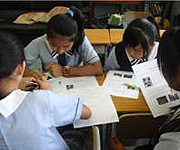
-
Grammar:
- prepositions of place
- prepositions indicating means of transport
-
Speaking skills:
- doing a presentation on a tourist attraction of choice
- opening and closing
- organising ideas
|
-
Jigsaw reading: Students read different texts for specific information about different tourist attractions and helped each other to complete the worksheet about the following:
- special features
- how to get there
- what can be done there
-
Students revisited the grammar points relevant to the tasks.
-
Students learnt the basic organisation of a presentation in class.
-
Guessing game: Groups described the tourist spots they would like to visit most for the other groups to guess which place it was.
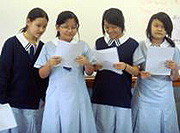
|
4 |
-
Vocabulary: recycling the names of HK tourist attractions and tourist activities learnt in previous lessons
-
Reading for specific information
-
Vocabulary and knowledge building: Stanley as a popular tourist attraction
|
-
A game: Teacher read sentences about a tourist attraction and students who had the card about it gave the card to the teacher. The first student who gave his/her card to the teacher was the winner.
-
Students read a text about Stanley to find out about:
- its special features
- how to get there
- what can be done there
|
5 - 6 |
-
Grammar:
-
Writing skills:
- setting questions for a questionnaire
-
Speaking and listening skills:
- asking and answering questions on the questionnaire
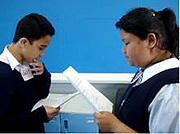
|
Preparation for outing
-
Teacher interviewed students using the sample questionnaire.
-
Students completed a dialogue about an interview in pairs and learned useful phrases and expressions for doing an interview.
-
Students practised conducting the interview in pairs with the completed dialogue and role cards ( controlled / free ).
-
Students revisited the structure of questions.
-
-
Teacher explained the guidelines and the content of their group project related to the outing.
-
Assignment: Students practised conducting the interview based on the questionnaire they set.
|
7 |
-
Speaking and listening skills: conducting an interview
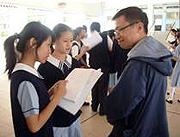
|
Mock interviews in covered playground
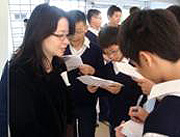
|
1 Day |
-
Speaking and listening skills
- conducting an interview
- note-taking
-
Writing skills
- A short description about their favourite spot in Stanley
- writing photo captions
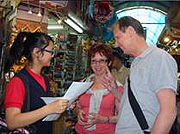
|
The English Outing Learning Day
-
Conducting the interview: Each student interviewed 2 - 4 English speaking foreigners.
-
Students had to take photos of popular tourist spots in Stanley.
-
Assignments:
- Each student had to write about his or her favourite spot in Stanley and illustrate the place with the photos taken during the outing. They had to write a caption for each photo. Their writing, photos and captions would be part of their group's report about the outing.
|
8 - 9 |
-
Speaking skills:
- reporting survey findings
- revising language for expressing, agreeing & disagreeing with opinions
- reading aloud
-
Reading & listening skills
- reading and listening for main ideas
-
Writing skills:
|
-
Each group prepared their survey report and then presented their findings in class.
-
In groups, students read aloud their writing about their favourite spot in Stanley and showed each other the photos while the other group members jotted notes about their presentation.
-
The students then selected the best piece of writing in their group and the teacher asked a member from the group at random to tell the class about the best piece of work in their group.
-
Class survey: The class voted for the most popular spot and activities in Stanley.
-
Teacher taught students the features of photo captions in class and class wrote the captions for their photos.
-
Assignment: Students completed their group project.
|

